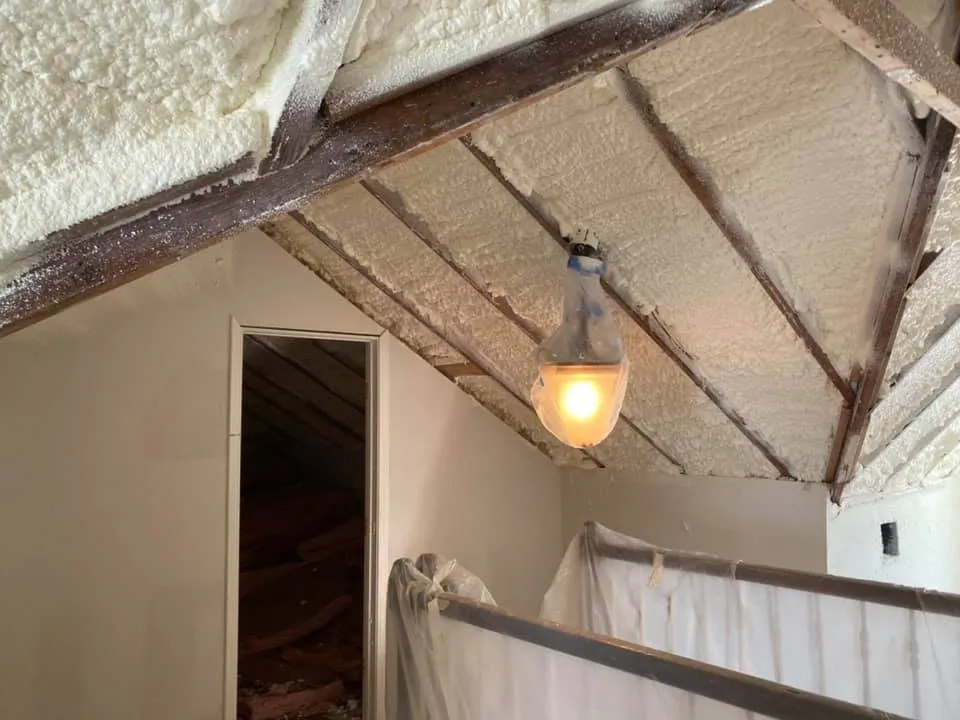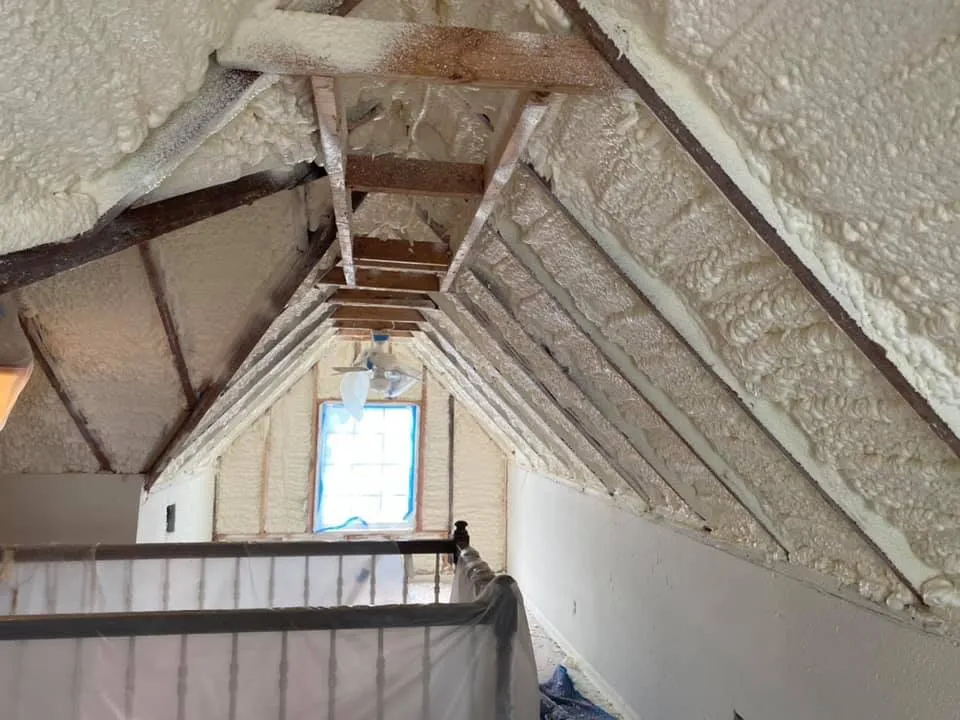Spray foam insulation resolves several frequent insulation issues found in Johnson City homes, including air leakage, inconsistent thermal barriers, and moisture intrusion. Unlike batt or blown-in materials that can sag, compress, or leave gaps, spray foam forms a continuous air seal that improves indoor comfort and energy performance year-round.
Inconsistent insulation around framing, poorly sealed attic hatches, exposed ductwork, and crawlspace vents are common culprits. Spray foam addresses these by expanding into cracks, bonding directly to substrates, and eliminating thermal bridging. Closed cell foam adds structural reinforcement and moisture resistance—a critical advantage in humid Southern climates.
This information is drawn from field data collected through thousands of insulation solutions in Johnson City, combined with performance results validated through blower door tests, thermal imaging, and post-installation energy audits.
Insulation Issues Spray Foam Resolves
Key Problems Found in Johnson City Homes
The table below outlines typical insulation failures in regional homes and how spray foam directly corrects them:
| Common Mistake | Description | Spray Foam Solution |
|---|---|---|
| Gaps in Batt Insulation | Irregular framing leaves voids batt can’t cover | Foam expands to fill all spaces and conforms to studs |
| Leaky Attic Hatches | Poorly sealed hatches cause large heat loss | Spray foam creates a sealed barrier around the frame |
| Uninsulated Rim Joists | These allow cold floors and air leaks | Closed cell foam air-seals and insulates simultaneously |
| Vented Crawlspaces | Vents introduce moisture and pests | Foam blocks vents and controls vapor transfer |
| Ducts in Unconditioned Spaces | Heat loss through exposed ductwork | Foam seals ducts and surrounding cavities |
| Settled or Compressed Insulation | Reduces R-value and increases infiltration | Foam maintains structure and R-value over time |
Bonus Tip
When evaluating attic performance, use infrared thermography before and after foam installation. It visibly confirms temperature consistency and reveals gaps missed by traditional methods.
Technical Performance of Spray Foam
| Attribute | Open Cell Spray Foam | Closed Cell Spray Foam |
|---|---|---|
| R-Value per Inch | ~3.6 | ~6.9 |
| Air Seal Capability | High | Very High |
| Moisture Barrier | Low | High |
| Structural Support | Minimal | Moderate |
| Application Areas | Walls, Attics, Interior Cavities | Crawlspaces, Basements, Rim Joists |
Source: Building Science Corporation; NAIMA Performance Studies
How Johnson City’s Climate Affects Insulation Choices
Johnson City experiences humid summers and variable winters. This mix amplifies the effects of poor insulation, especially in crawlspaces and attics where thermal pressure and moisture buildup are common.
- Humidity promotes mold growth in fiberglass batts and cellulose if not sealed.
- Seasonal Temperature Swings test insulation’s ability to maintain stable indoor temperatures.
- Stack Effect pulls unconditioned air into homes through leaks in lower levels, forcing conditioned air out the top. Spray foam neutralizes this pressure.
Bonus Tip
In crawlspaces, closed cell foam not only insulates but creates a vapor barrier on block walls, stopping both air and moisture movement at once.
Market Data on Effectiveness
- ENERGY STAR estimates show spray foam reduces heating and cooling costs when used to seal common leak points.
- Oak Ridge National Laboratory studies confirm closed cell foam reduces air leakage more than compared to batt insulation in rim joist areas.
- EPA Indoor airPLUS program recommends spray foam in crawlspaces to reduce moisture and radon entry risks.
Things to Consider Before Making a Decision
- Building Age: Older homes often lack air sealing. Blown-in insulation alone won’t address gaps around framing.
- Area of Application: Attics, walls, crawlspaces, and basements have different insulation needs.
- Budget and ROI: Spray foam costs more upfront but often reduces HVAC sizing needs and energy bills.
- Moisture Conditions: High humidity or past mold issues point to closed cell as the safer long-term choice.
- Access Limitations: Some tight or obstructed cavities may not accommodate batt or blown-in materials.

Key Services That Address These Problems
Insulation Removal
Removes old, underperforming insulation to prepare surfaces for air sealing and spray foam application.
Attic Insulation
Improves thermal performance and blocks air loss through roof decks, recessed lighting, and knee walls.
Crawlspace Insulation
Stops moisture intrusion and air leaks from vented or dirt-floored crawlspaces.
Wall Insulation
Fills wall cavities fully, reducing drafts and stabilizing interior room temperatures year-round.
Common Questions About Solving Insulation Mistakes
Can spray foam be used over old insulation?
No. Existing insulation must be removed to ensure foam adheres properly and provides full air sealing.
How long does spray foam insulation last?
It remains effective for decades. Closed cell foam resists moisture and doesn’t degrade like fibrous materials.
Will spray foam fix high humidity indoors?
In part. By sealing air leaks and controlling vapor intrusion, foam reduces the load on dehumidifiers and HVAC.
Is spray foam safe for homes with children?
Yes. Once cured, it is inert and does not off-gas harmful chemicals.
Summary of Key Insights
Spray foam insulation in Johnson City solves frequent insulation problems by sealing gaps, stabilizing temperatures, and reducing moisture risks. In Johnson City, where humidity and mixed seasonal climates are common, these advantages directly improve comfort and efficiency. Assess building condition, specific areas of concern, and long-term performance needs before choosing insulation.
Get Expert Insulation Guidance
For expert help identifying and resolving insulation issues, contact:
Email: info@stellrr.com
Phone: (512) 710-2839
FAQs
How is open cell different from closed cell in performance?
Closed cell has higher R-value and resists moisture, making it ideal for basements and crawlspaces. Open cell is more flexible and suited for interior cavities.
Can spray foam insulation be applied in winter?
Yes, but product temperature and humidity must be managed carefully during application to ensure proper curing.
What maintenance does spray foam require?
None, unless it is physically damaged during construction work. It does not settle or compress.
Can it be used with other insulation types?
Yes. Hybrid systems often combine spray foam for air sealing with cellulose for cost-effective R-value.
What are signs my current insulation is failing?
High energy bills, inconsistent indoor temperatures, visible gaps in insulation, and drafts are common indicators.

